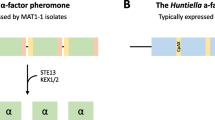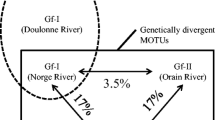Abstract
The mate recognition protein (MRP) gene is a member of a family of extracellular matrix protein genes, called MRP Motif Repeat (MMR) genes, with no known homologs. Two sets of MMR genes, designated MMR-A and MMR-B, were found in Brachionus manjavacas. MMR-B has previously been shown to encode the MRP in the Brachionus plicatilis species complex. MMR family genes share the same basic structure: a signal peptide sequence, followed by nearly identical 276 bp (MMR-A) or 261 bp (MMR-B) repeats, with a truncated final repeat. Each repeat of the predicted MMR-A and -B proteins is expected to have a secondary structure of 5 α-helices, ranging in length from 11 to 20 amino acids, separated by coils of 1–3 amino acids. Hydrophobic and hydrophilic amino acids are predicted to be partitioned to opposite sides of each α-helix, suggesting that MMR proteins are globular with a hydrophobic core. MMR-A and MMR-B proteins vary in their post-translational modifications, resulting in differences in size and charge, and likely causing differences in the physical properties of the proteins on the surface of the female, and their ability to be recognized by a receptor on a male rotifer. The identity of MMR gene repeats is theorized to be maintained by concerted evolution, through a process of unequal crossing over and/or gene conversion, with new mutations likely to be lost. Rarely, however, the same process of concerted evolution can rapidly spread a mutation across all of the repeats. When a mutation results in conformational changes in the protein detectable by males, it could lead to reproductive isolation and thereby to speciation. Thus, changes in MRP could be a driving force in the high degree of species diversity seen within the B. plicatilis cryptic species complex.


Similar content being viewed by others
References
Bendsten, J. D., H. Nielsen, G. Von Heijne & S. Brunak, 2004. Improved prediction of signal peptides: SignalP 3.0. Journal of Molecular Biology 340: 783–795.
Bennett, R. J., M. A. Uhl, M. G. Miller & A. D. Johnson, 2003. Identification and characterization of a Candida albicans mating pheromone. Molecular and Cellular Biology 23: 8189–8201.
Berrieman, H. K., D. H. Hunt & A. Gómez, 2005. Behavioural reproductive isolation in a rotifer hybrid zone. Hydrobiologia 546: 125–134.
Blom, N., S. Gammeltoft & S. Brunak, 1999. Sequence and structure-based prediction of eukaryotic protein phosphorylation sites. Journal of Molecular Biology 294: 1351–1362.
Derry, A. M., P. D. N. Hebert & E. E. Prepas, 2003. Evolution of rotifers in saline and subsaline lakes: a molecular phylogenetic approach. Limnology and Oceanography 48: 675–685.
Dover, G., 1982. Molecular drive: a cohesive mode of species evolution. Nature 299: 111–116.
Elder, J., F. John & B. J. Turner, 1995. Concerted evolution of repetitive DNA sequences in eukaryotes. The Quarterly Review of Biology 70: 297–320.
Ferris, P., C. Pavlovic, S. Fabry & U. W. Goodenough, 1997. Rapid evolution of sex-related genes in Chlamydomonas. Proceedings of the National Academy of Sciences USA 94: 8634–8639.
Fontaneto, D., I. Giordani, G. Melone & M. Serra, 2007. Disentangling the morphological stasis in two rotifer species of the Brachionus plicatilis species complex. Hydrobiologia 583: 297–307.
Garnier, J., D. Osguthorpe & B. Robson, 1978. Analysis of the accuracy and implications of simple methods for predicting the secondary structure of globular proteins. Journal of Molecular Biology 120: 97–120.
Gilbert, J. J., 1963. Contact chemoreception, mating behaviour, and sexual isolation in the rotifer genus Brachionus. Journal of Experimental Biology 40: 625–641.
Gilbert, J. J. & E. J. Walsh, 2005. Brachionus calyciflorus is a species complex: mating behavior and genetic differentiation among four geographically isolated strains. Hydrobiologia 546: 257–265.
Gómez, A. & M. Serra, 1996. Mate choice in male Brachionus plicatilis rotifers. Functional Ecology 10: 681–687.
Gómez, A., M. Serra, G. R. Carvalho & D. H. Lunt, 2002. Speciation in ancient cryptic species complexes: evidence from the molecular phylogeny of Brachionus plicatilis (Rotifera). Evolution 56: 1431–1444.
Guillard, R. R. L., 1975. Culture of phytoplankton for feeding marine invertebrates. In Smith, W. L. & M. H. Chanley (eds), Culture of Marine Invertebrates. Plenum Publishing Corporation, New York, New York.
Horth, L., 2007. Sensory genes and mate choice: evidence that duplications, mutations, and adaptive evolution alter variation in mating cue genes and their receptors. Genomics 90: 159–175.
Liao, D., 1999. Concerted evolution: molecular mechanism and biological implications. American Journal of Human Genetics 64: 24–30.
Mark Welch, D. B. & M. Meselson, 1998. Measurements of the genome size of the monogonont rotifer Brachionus plicatilis and of the bdelloid rotifers Philodina roseola and Habrotrocha constricta. Hydrobiologia 387(388): 395–402.
Mark Welch, D. B., J. L. Mark Welch & M. Meselson, 2008. Evidence for degenerate tetraploidy in bdelloid rotifers. Proceedings of the National Academy of Sciences USA 105: 5145–5149.
Mayfield, J. A., A. Fiebig, S. E. Johnstone & D. Preuss, 2001. Gene families from the Arabidopsis thaliana pollen coat proteome. Science 292: 2482–2485.
Nei, M. & T. Gojobori, 1986. Simple methods for estimating the numbers of synonymous and nonsynonymous nucleotide substitutions. Molecular Biology and Evolution 3: 418–426.
Puntervoll, P., R. Linding, C. Gemund, S. Chabanis-Davidson, M. Mattingsdal, S. Cameron, D. M. A. Martin, G. Ausiello, B. Brannetti, A. Costantini, F. Ferre, V. Maselli, A. Via, G. Cesareni, F. Diella, G. Superti-Furga, L. Wyrwicz, C. Ramu, C. Mcguigan, R. Gudavalli, I. Letunic, P. Bork, L. Rychlewski, B. Kuster, M. Helmer-Citterich, W. N. Hunter, R. Aasland & T. J. Gibson, 2003. ELM server: a new resource for investigating short functional sites in modular eukaryotic proteins. Nucleic Acids Research 31: 3625–3630.
Rice, P., I. Longden & A. Bleasby, 2000. EMBOSS: The European Molecular Biology Open Software Suite. Trends in Genetics 16: 276–277.
Rico-Martínez, R. & T. W. Snell, 1997. Binding and blocking of mating in Brachionus plicatilis (Muller) and Brachionus rotundiformis (Tschugunoff) (Rotifera) females by an antibody against the mate recognition pheromone. Hydrobiologia 358: 71–76.
Rozas, J., J. C. Sanchez-Delbarrio, X. Messeguer & R. Rozas, 2003. DnaSP, DNA polymorphism analyses by the coalescent and other methods. Bioinformatics 19: 2496–2497.
Snell, T. W., 1989. Systematics, reproductive isolation and species boundaries in rotifers. Hydrobiologia 186(187): 299–310.
Snell, T. W. & C. A. Hawkinson, 1983. Behavioral reproductive isolation among populations of the rotifer Brachionus plicatilis. Evolution 37: 1294–1305.
Snell, T. W., R. Rico-Martinez, L. N. Kelly & T. E. Battle, 1995. Identification of a sex pheromone from a rotifer. Marine Biology 123: 347–353.
Snell, T. W., T. L. Shearer, H. A. Smith, J. Kubanek, K. E. Gribble & D. B. Mark Welch, 2009. Genetic determinants of mate recognition in Brachionus manjavacas (Rotifera). BMC Biology 7: 60.
Snell, T. W., T. L. Shearer & H. A. Smith, 2010. Exposure to dsRNA produces RNA interference in Brachionus manjavacas (Rotifera). Mar Biotech. doi:10.1007/s10126-010-9295-x.
Suatoni, E., S. Vicario, S. Rice, T. Snell & A. Acaccone, 2006. An analysis of species boundaries and biogeographic patterns in a cryptic species complex: the rotifer–Brachionus plicatilis. Molecular Phylogenetics and Evolution 41: 86–98.
Vacquier, V. D., 1995. Evolution of gamete recognition proteins. Science 281: 1995–1998.
Acknowledgments
The authors wish to thank Bette Hecox-Lea for technical assistance and Atushi Hagiwara and an anonymous reviewer for comments that improved the manuscript. This research was supported by the National Science Foundation grant BE/GenEn MCB-0412674 to TWS and DBMW and a Neil Cornell Career Development Award to DBMW.
Author information
Authors and Affiliations
Corresponding author
Additional information
Guest editors: N. Walz, R. Adrian, J.J. Gilbert, M.T. Monaghan, G. Weithoff & H. Zimmermann-Timm / Rotifera XII: New aspects in rotifer evolution, genetics, reproduction, ecology and biogeography
Rights and permissions
About this article
Cite this article
Gribble, K.E., Snell, T. & Mark Welch, D.B. Gene and protein structure of the mate recognition protein gene family in Brachionus manjavacas (Rotifera). Hydrobiologia 662, 35–42 (2011). https://doi.org/10.1007/s10750-010-0482-6
Published:
Issue Date:
DOI: https://doi.org/10.1007/s10750-010-0482-6




